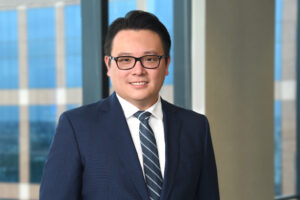Other Available Languages:
April 2021 Federal Circuit Newsletter (Japanese)
April 2021 Federal Circuit Newsletter (Chinese)
Copying From a Copyrighted Computer Program May Be Fair Use to the Extent Needed to Promote Adoption of the Use of Accrued Talents in Creating a New Software Platform
In Google LLC v. Oracle America, Inc., Appeal No. 18-956, the Supreme Court held that, where use of copyrighted computer code is inherently bound together with uncopyrightable ideas and new creative expression, it may be fair use to copy that which is needed to reimplement a user interface for others to make use of their accrued talents.
Google sought to use Oracle’s Java platform to create a software platform for smartphones, but was unable to agree to a license. Google built its own Android platform and copied a portion of Oracle’s Application Programming Interface (“API”) from the Java platform. Oracle sued Google for copyright infringement. The district court found that the copied code was not protected by copyright. On appeal, the Federal Circuit reversed the copyrightability determination and remanded for a trial on the issue of fair use. The district court held a jury trial solely on the issue of fair use. The jury found that Google had shown fair use. On appeal, the Federal Circuit reversed again, holding Google’s use of the Java API was not fair use and remanded for a trial on damages. Google appealed to the Supreme Court.
The Supreme Court granted certiorari. The Supreme Court did not address the copyrightability of the Java API, and instead assumed that it is copyrightable. The Supreme Court then addressed the issue of fair use. The Supreme Court agreed with the Federal Circuit that fair use is a mixed question of fact and law, with deference to a jury’s findings of underlying fact and the ultimate question on fair use decided by the judge de novo. The Supreme Court applied the four statutory factors for fair use: (1) purpose and character of the use; (2) nature of the copyrighted work; (3) amount and substantiality of the portion taken; and (4) effect of the use upon the potential market. The Supreme Court found that all factors favored Google and reversed the Federal Circuit, holding that Google’s use of the Java API was a fair use because Google only took what was needed to allow Java programmers to use their learned skills in a new and transformative program.
First, the Supreme Court noted that the nature of the copied Java API differed from other kinds of copyrightable computer code. The copied Java API was bound up inextricably to uncopyrightable ideas, such as the idea of organizing tasks, as well as to uncopied portions of the Java API that actually instructs the computer on steps to carry out a task. The Supreme Court held that the value of the copied code derived from the investment of time and effort of programmers in adopting the new system. These considerations made the copied portions further from the core of copyright than most computer programs. Second, the Supreme Court held that Google’s purpose for using the Java API, to reimplement a user interface that could readily be used by other programmers, was consistent with the constitutional objective of copyright in promoting “progress,” and was transformative. Third, the Supreme Court held that Google did not copy the code for its creativity or purpose, but to facilitate others to adopt the new Android platform and write new programs using their Java experience. Fourth, the Supreme Court held that that there was evidence that Oracle was not in a position to benefit financially from the smartphone market, that Android was a distinct and more advanced market from the Java platform, and that Oracle foresaw a benefit from broader use of the Java programming language through Android.
Justice Thomas dissented, contending that the Copyright Act’s statutory definition of computer program covered the copied code. Thus, while Oracle cannot copyright the idea underlying the copied code, it can copyright the specific expression of the idea represented in the copied code. The dissent also disagreed with the four-factor fair use analysis, noting that at least three of the four factors favored Oracle. In support of an absence of fair use, the dissent noted that Google’s copying decimated Oracle’s market and interfered with Oracle’s licensing opportunities; Google’s purpose for copying was overwhelmingly commercial; and the substantial copying is what attracted programmers to the Android platform.
Hurdles in the Admissibility of Source Code and Expert Reliance on Unauthenticated Source Code
In Wi-Lan Inc. v. Sharp Electronics Corporation, Appeal No. 20-1041, the Federal Circuit held that source code evidence was inadmissible hearsay with no exception to save it.
Wi-LAN sued Sharp and Vizio in parallel litigations for patent infringement and the parties filed cross-motions for summary judgment. The district court granted Sharp and Vizio’s motion for summary judgment of noninfringement because it found that Wi-LAN’s evidence – source code printouts and supporting declarations from third-party manufacturers purporting to authenticate the source code – was inadmissible. Wi-LAN appealed.
On appeal, Wi-LAN argued that its source code evidence should be admissible under Fed. R. Evid. 803(6) as a business record; under Fed. R. Evid. 901(b)(4); and under Fed. R. Evid. 703 as evidence relied on by an expert. The Federal Circuit rejected each of those arguments. The Federal Circuit held that the declarations submitted on summary judgment were not a proper proxy for trial testimony because the manufacturer-declarants needed to be available to testify at trial, which Wi-LAN admitted was unlikely. The Federal Circuit also agreed that the source code and declarations were not business records because they were not kept in the ordinary course of business. Instead, Wi-LAN filed lawsuits against the manufacturers and then dismissed them after the manufacturers created and provided Wi-LAN with the source code printout and declarations it sought. The evidence also lacked trustworthiness in view of inconsistencies in the data and Wi-LAN’s failure to obtain change logs explaining those inconsistencies, among other issues. The Federal Circuit rejected the application of Rule 901(b)(4) for lack of trustworthiness of the evidence. Finally, the Federal Circuit rejected Wi-LAN’s argument that the source code printout was admissible as evidence relied on by an expert, explaining that expert reliance does not translate to admissibility. Accordingly, the Federal Circuit affirmed.
Licensee Lacks Standing to Appeal an Adverse IPR Decision Based on Royalty Payments for a Patent Portfolio and a Speculative Post-License Lawsuit
In Apple, Inc. v. Qualcomm, Inc., Appeal No. 20-1561, the Federal Circuit held that Apple lacked standing to appeal an IPR decision upholding patents it licensed from Qualcomm, despite Apple’s royalty payments for a portfolio including the patents at issue and the possibility that Qualcomm could assert those patents against Apple after the license expired.
Qualcomm sued Apple for patent infringement of two Qualcomm patents. In response, Apple petitioned for inter partes review (IPR) of Qualcomm’s patents. The Patent Trial and Appeal Board issued final written decisions holding Apple did not prove that the challenged claims in either patent would have been obvious. Apple and Qualcomm then settled all litigation between the two companies worldwide. The settlement included a six-year license agreement for a large portfolio of patents, including the patents at issue. Apple then appealed the Board’s final written decisions.
The Federal Circuit found that Apple failed to establish standing to bring its appeal. First, it rejected Apple’s argument that its payment of royalties for the portfolio of patents confers standing to challenge the validity of individual patents in the portfolio, reasoning that the validity of the two challenged patents would not impact Apple’s royalty obligations. Second, the court rejected Apple’s assertion of standing based on the possibility that Qualcomm may sue Apple for infringing the patents at issue after the license expires, finding Apple’s assertions lacked the specificity necessary to show that Qualcomm is likely to assert the particular patents against particular products that would be sold after the expiration of the license agreement. Third, the Federal Circuit rejected any contention that the harm Apple may face from IPR estoppel confers standing, again noting Apple failed to show it would likely engage in activities that could give rise to a lawsuit based on the patents at issue. The court therefore dismissed the appeal.
A Standalone Obviousness Reference Must Be Enabling to Invalidate
In Raytheon Technologies v. General Electric, Appeal No. 20-1755, the Federal Circuit held that unrebutted evidence of non-enablement is sufficient to overcome an invalidity challenge based on a standalone §103 reference.
Raytheon owned a patent claiming a gas turbine engine having a particular power density. GE petitioned for inter partes review of Raytheon’s patent, relying on a NASA technical memorandum (“Knip”) as a standalone §103 prior art reference. In response, Raytheon argued that Knip’s disclosure did not enable or render obvious the claimed invention because Knip’s “imagined” composite materials were unattainable when Raytheon filed its patent. The Board ultimately held that Knip’s disclosure was “enabling” and rendered Raytheon’s patent claims obvious. The Board’s enablement analysis focused on one of the claimed limitations—the power density—instead of the claimed invention as a whole. Raytheon appealed.
On appeal, Raytheon argued that the Board erred by considering only whether Knip enabled a skilled artisan to calculate power density, rather than considering whether Knip enabled a skilled artisan to make the claimed turbine engine. Raytheon’s unrebutted evidence demonstrated that Knip’s disclosure had not been achieved by an actual turbine engine at the time of patent filing. GE, on the other hand, argued that it was irrelevant whether Knip actually enabled a skilled artisan to build the hypothetical engine that Knip disclosed.
The Federal Circuit reversed. The court first explained that even a non-enabling reference can play a role in the obviousness analysis based on its teachings. The court then qualified this general rule, and explained that when a patent challenger relies on a single reference for both obviousness and self-enablement, the reference’s disclosure must enable the claimed invention. Raytheon’s unrebutted evidence demonstrated that Knip’s disclosure did not enable the claimed invention. Thus, the court reversed the holding of obviousness.

